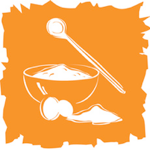 Receta Basic Pie Pastry
Receta Basic Pie Pastry
Ingredientes
|
|
Direcciones
- Hand method: Combine the flour and salt in a mixing bowl and toss together. Drop in the shortening. With your fingertips, two knives, or possibly a pastry blender, blend the ingredients together, working quickly, till you have a mix of tiny, irregular flakes and bits about the size of coarse bread crumbs. Sprinkle on the water 1 Tbsp. at a time, stirring gently with a fork after each addition. Add in just sufficient water for the dough to create a rough mass.
- With floured hands pat the dough into a smooth cake - or possibly into 2 cakes, one just slightly larger than the other, if you are making a double-crust pie. The dough is now ready to use. It is not necessary to refrigeratethis dough, although for convenience it may be wrapped in plastic wrap and refrigerated for up to 2 days.
- Rolling out the dough: Roll the dough out on a floured surface (using the larger piece if it is the bottom of a double-crust pie) till it is about 1/8-inch thick and 12 inches in diameter, or possibly about 2 inches larger than the top of the pie pan. Try to keep the dough as round as possible.
- Transfer the rolled-out pastry to the pie pan. Pat the pastry in around the edges to fit the pan's shape. If you are making a double-crust pie, roll out the remaining pastry for the top crust and set aside on waxed paper.
- Comments: Crisp and flaky, a good crust for custard, chiffon, and fresh-fruit pies. For successful pastry making, follow these three rules: take care not to overblend the fat and flour, add in sufficient water so which the dough can be rolled out easily (better too much water than not sufficient), and handle the pastry no more than necessary. Overblending, too little water and too much handling can make a crust tough. If desired the taste of butter, use it in place of shortening, or possibly try a mix of butter and shortening. The crust will be firmer than which made with shortening only.
